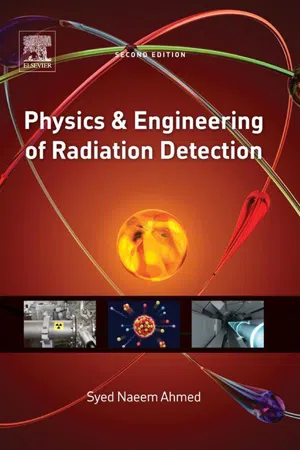
- 784 pages
- English
- ePUB (mobile friendly)
- Available on iOS & Android
Physics and Engineering of Radiation Detection
About this book
Physics and Engineering of Radiation Detection presents an overview of the physics of radiation detection and its applications. It covers the origins and properties of different kinds of ionizing radiation, their detection and measurement, and the procedures used to protect people and the environment from their potentially harmful effects.The second edition is fully revised and provides the latest developments in detector technology and analyses software. Also, more material related to measurements in particle physics and a complete solutions manual have been added.- Discusses the experimental techniques and instrumentation used in different detection systems in a very practical way without sacrificing the physics content- Provides useful formulae and explains methodologies to solve problems related to radiation measurements- Contains many worked-out examples and end-of-chapter problems- Detailed discussions on different detection media, such as gases, liquids, liquefied gases, semiconductors, and scintillators- Chapters on statistics, data analysis techniques, software for data analysis, and data acquisition systems
Frequently asked questions
- Essential is ideal for learners and professionals who enjoy exploring a wide range of subjects. Access the Essential Library with 800,000+ trusted titles and best-sellers across business, personal growth, and the humanities. Includes unlimited reading time and Standard Read Aloud voice.
- Complete: Perfect for advanced learners and researchers needing full, unrestricted access. Unlock 1.4M+ books across hundreds of subjects, including academic and specialized titles. The Complete Plan also includes advanced features like Premium Read Aloud and Research Assistant.
Please note we cannot support devices running on iOS 13 and Android 7 or earlier. Learn more about using the app.
Information
Properties and sources of radiation
Keywords
1.1 Types of radiation
Table of contents
- Cover image
- Title page
- Table of Contents
- Copyright
- Dedication
- Preface to the second edition
- Preface to the first edition
- 1. Properties and sources of radiation
- 2. Interaction of radiation with matter
- 3. Gas-filled detectors
- 4. Liquid-filled detectors
- 5. Solid-state detectors
- 6. Scintillation detectors and photodetectors
- 7. Position-sensitive detection and imaging
- 8. Signal processing
- 9. Essential statistics for data analysis
- 10. Software for data analysis
- 11. Dosimetry and radiation protection
- 12. Radiation spectroscopy
- 13. Data acquisition systems
- Appendix A. Essential electronic measuring devices
- Appendix B. Constants and conversion factors
- Appendix C. VME connector pin assignments